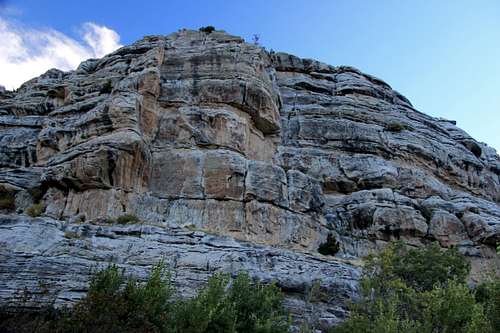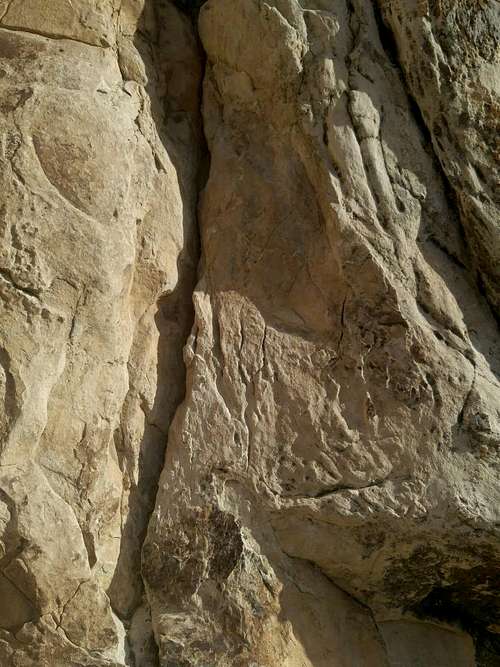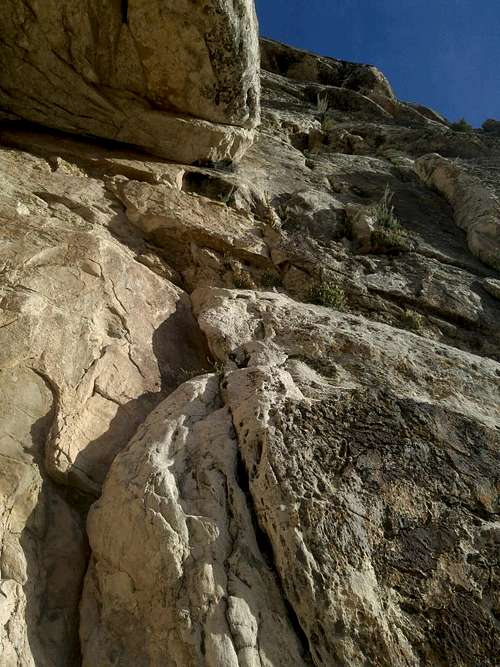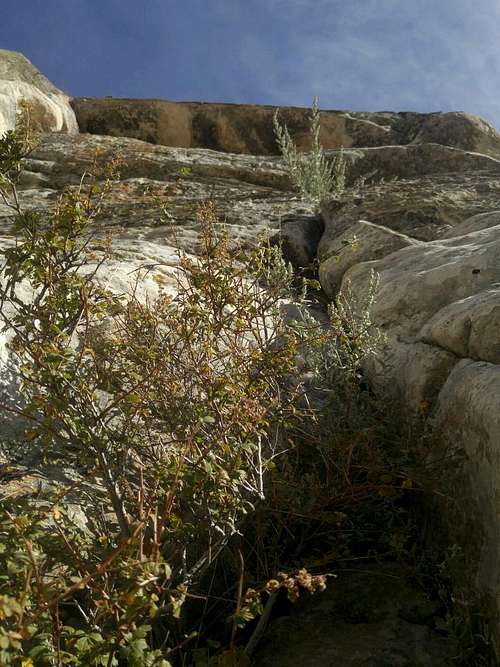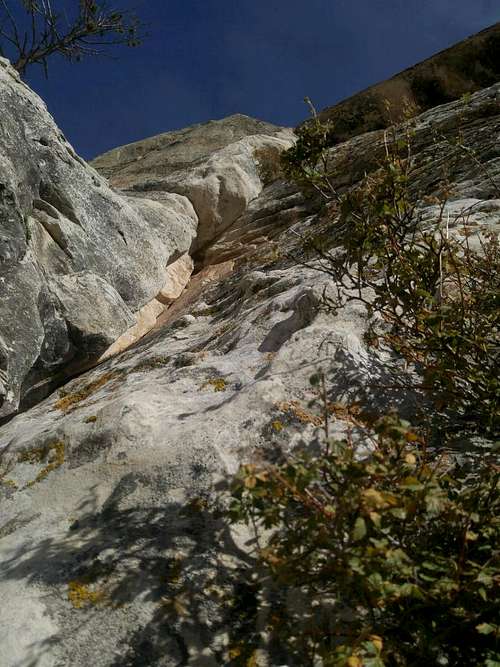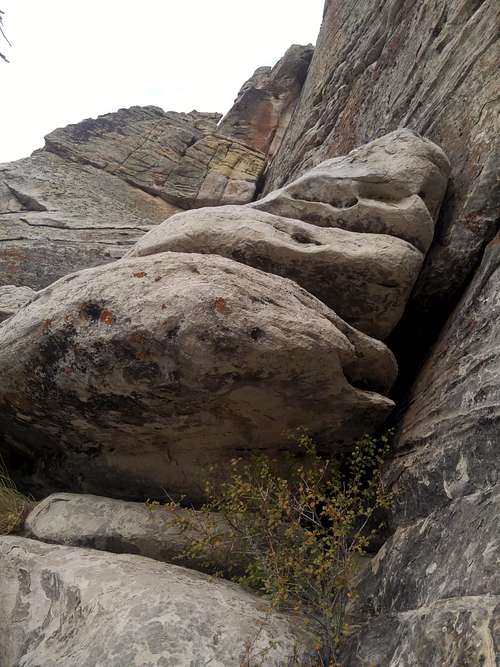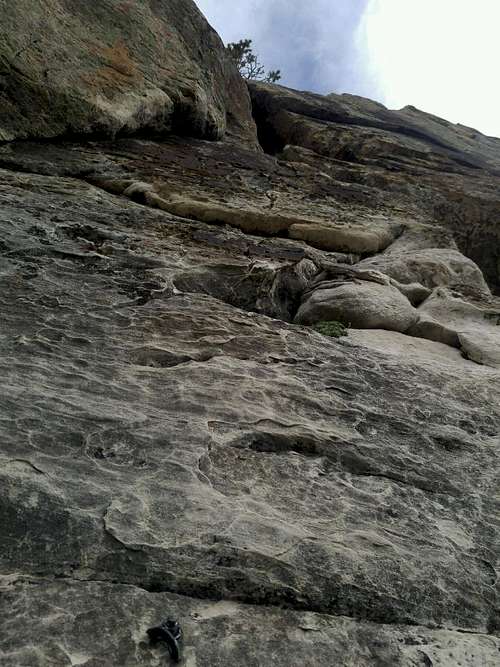-
 2277 Hits
2277 Hits
-
 76.66% Score
76.66% Score
-
 7 Votes
7 Votes
|
|
Route |
|---|---|
|
|
42.76038°N / 108.80518°W |
|
|
Trad Climbing |
|
|
Spring, Summer, Fall, Winter |
|
|
Half a day |
|
|
5.6 with a 5.8 Option |
|
|
5.6 (YDS) |
|
|
4 |
|
|
Overview
Yes, this is actually the name of the route.
I don't know if its name refers to its being the easiest route or the first technical climbing route up Sandstone Buttress, or if the first ascentionist just didn't have a better name in mind, but regardless, it is the easiest route to the top and it is quite fun as well.
Although the traditional route is 5.6, with the crux coming on the third of the four pitches, there is a nice alternative finish that goes at 5.8 instead of 5.easy. Thus, this route is good for newer leaders and for leaders wanting to step it up a bit without thing getting too committing. The 5.8 finish is not sustained at the grade, with one, maybe two, 5.8 moves, and it is well protected.
At just 200' of vertical climbing, you would expect two or perhaps three pitches, but the pitches meander enough that there are four. One could make it three or even two, but there would be major rope drag.
This route gets morning sun, so take that into account depending on the time of year.
Getting There
From downtown Lander, follow signs to Sinks Canyon State Park. It takes about 15 minutes to reach the park boundary.
Sandstone Buttress is the first large formation on the right after you cross into the state park. There is a large parking area, with trash cans and an interpretive sign about Sinks Canyon; right across the road is a group area with restrooms and an elephant kids like to climb on. You can't miss this unless you're blind or so absorbed by your phone that you might as well be.
If you have reached Sinks Canyon the other way, from WY 28, then note that Sandstone Buttress is the last formation on the left before you leave the state park.
Route Description
Follow trails up to a ledge. Walk along the ledge past two 40' crack routes with chains and rings for anchors. The route starts at the first obvious break you reach.
P1-- 5.2? My partner felt more comfortable roping up, so we did, but the day before, I scrambled up this pitch to set topropes on the anchors of the two aforementioned crack routes. The start is dirty and chossy and has lousy pro. There is good pro at the only real Class 5 section, a short push up a corner to a broad ledge. Belay off bolted anchors.
P2-- 5.5. Walk left along the ledge to a crack system. Don't use the big, beautiful crack in the corner unless you want to make this pitch significantly harder, as the crack leads to a big roof and a traverse beneath it. Instead, use a different crack system to its right. The climbing was fun and easy, but the pro was so-so. It seemed one piece was great and the next was sketchy due to flares. I did not have my offsets and wished I did. Belay off bolted anchors.
P3-- 5.6. Head straight up and then traverse left to a chimney and corner. There is a bolt along the traverse. The crux is exiting the chimney onto the belay ledge above. It is a fun, awkward, and exposed move, but everything's there and the pro is good. Belay off bolted anchors.
P4 (Standard)-- Class 4-5.2? Finish up and left on easy ground. I have not gone this way. What I've read suggests it is mostly a scramble. Belay off bolted anchors.
P4 (Alternative)-- 5.8. Head straight up the slab on thin but good holds. Clip the bolt. Move up into the corner and pull the small roof. I would call the roof the physical crux and the slab before the bolt the mental one. You can get fall-all-day placements to protect the roof moves. I would add that I felt this 5.8 was easier than 5.8 I have done on granite and limestone, but I would also add that for whatever reason, in general I find sandstone routes easier for the grade than I do on those other rock types. Belay from bolted anchors.
Descent-- Easiest and safest, and most considerate if there is another party on the route, is to follow trails back down. However, you can, starting on the 5.8 alternative anchors, make it down in two raps with one 60 rope.
Essential Gear
I led this with a set of Ultralight Master Cams, the Demon Cam between a C4 #3 and #4, a C4 #4, a set of stoppers, and some Dyneema hexes in the range of BD C4 .75-2.Offset stoppers would be good for P2.


